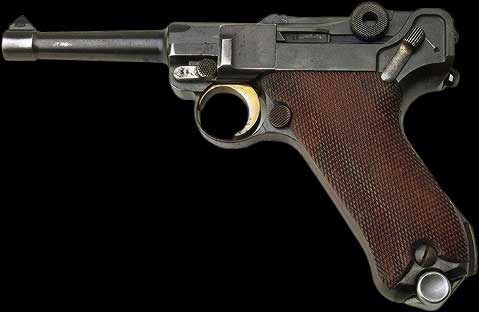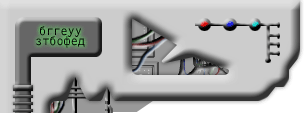|

When the predecessor to the Maschinenpistole 40 or the MP40, the MP38, was first produced in 1938, the design was
revolutionary because of the way the weapon was manufactured. The weapon itself is quite orthodox. Unlike the
Luger, the MG34 and the all other German small arms before it, the MP38 was designed for mass production, like the Model T
Ford. Parts were primarily stamped instead of machined, finishing was modest and the stock woodless. The
goal: Mass arming of Germany's storm-troopers with a capable and inexpensive yet reliable submachine gun.
For the
most part, the MP38 met this design goal except for one nasty problem. When jarred, the gun often did start firing
by itself. This run-away submachine gun caused numerous friendly casualties. The next generation, the MP40, fixed
the flaw. Mass production was taken to even a higher level with the use of even more simple and inexpensive stamped
parts and futher streamlining of production.
The result: the weapon was churned out in large numbers. Just over
one million were made of all versions in the course of the war. The gun had relatively low recoil even fired fully automatic.
This is due to its slower rate of fire and its 9MM bullet. Nevertheless, it gave the Maschinenpistole 40 a respectable
accuracy compared to the American Thompson. The resulting sound provided a nickname, the "Burp gun."
The MP40 is often incorrectly called the Schmeisser, after weapons designer Hugo Schmeisser. The weapon was coveted
by the Germans and the Allies. Because of its light weight, the gun was highly esteemed and favored by the German
Fallshirmjägers paratroopers and panzer grenadiers.
|
|

The Mauser Luger is often designated by the number 42 on the top of the receiver or BYF markings. The luger
was first introduced as the standard German sidearm in 1908 and is referred to as the P08. It was designed by Georg Luger
who also developed the 9mm Parabellum. The 9mm Parabellum also goes by the names 9mm Luger and 9x19mm, and is distinct from
a number of other cartridges that use the designation "9mm" in their names (such as 9mm short, 9mm Makarov, 9mm largo).
In the pre-WWI period Lugers were produced by the German government arms factory in Erfurt as well as by Loewe
& Co., which was at that time named Deutsche Waffen und Munitionsfabriken (DWM). The Luger was the standard German sidearm
throughout World War I. Luger production continued sporadically during the post-war period, in part due to restrictions on
German arms manufacture imposed by the Treaty of Versailles. The allies permitted official production to begin in 1925 at
Simson and company. Simson, however, was owned by Jews, and the company was liquidated when the Nazis came into power. The
Luger manufacturing machinery was purchased by Krieghoff. Mauser purchased DWM's Luger manufacturing machinery in 1929, and
produced Lugers until the later part of World War II. The Luger was officially replaced for German military use in 1940 by
the Walther P38 double-action 9mm Parabellum pistol.
Mauser produced a series of Lugers somewhat similar to the Swiss military model in the early 1970's.

The standard German infantry weapon was the rifle, originally designed by Mauser and dubbed the Karabiner
98k. This weapon was a 5-shot, bolt-action rifle that actually dated back to 1898 when it was first adopted by the Imperial
German Army. It was standard issue for German troops in WWI and, in its modified 98k version (k for kurz, or short), in WWII
as well.
While the German standard rifle was a bolt action rifle, the Germans did attempt to design a successful automatic
rifle as well. Two designs were submitted for trials in 1941, one by Walther (the maker of the famous PPK and the P38 pistols),
and the other was submitted by Mauser. The Mauser design won out over the simpler Walther design and many thousands of the
Gewehr 41(W) were made available to the troops on the Eastern Front. After initial use, results were less than satisfactory
and as soon as a better design came along, production was haulted. The way in which German troops used their weapons changed
and a rifle with a range of 2000 yards was no longer needed - except for specialists and snipers. Instead, ranges had shrunk
down to 400 yards and a less powerful cartridges was needed.
The most common submachine gun used by the Germans during
WWII was the MP40. Many times the term "Schmeisser" is used in reference to a German submachine gun. While it is true that
the Schmeisser firm did create and produce its own submachine gun design, it was less than perfect and prone to trouble. The
MP40 was a not manufactured by Schmeisser, and the weapon was far more simple and had a much more cleaner design, thus it
became the standard issue for German troops. An earlier design called MP38 had a similar appearance and saw widespread distribution.
A less known model called Erma was also produced as well as a German copy of the British STEN gun, called MP3008. The Waffen-SS
used a submachine gun made by Bergman called the MP34 also.
The next submachine gun design to emerge was the MP43 or
Machine Pistol 43 from a design developed in 1943. It fired a less powerful cartridge and had a lighter recoil as a result.
However, Hitler, still thinking that troops needed a weapon capable of firing 2000 yards, ordered that production of the weapon
not start. The German arms minister, however, knew the need of the new weapon, and changed the name to "Machine Pistol", which
is what the Germans called their submachine guns like the US Thompson .45 cal. The trick worked and the weapon went into production
at three factories and German troops all over the Eastern Front were clamoring for the new weapon. The whole affair was blown"
when a few divisional commanders asked Hitler at a conference when they would get the new weapon. Hitler was furious and ordered
an investigation. Luckily for the men that had disobeyed the Führer, the results of the investigation were so encouraging
about the new weapon that Hitler changed his mind and announced that henceforward the weapon would be called "Sturmgewehr"
or Assault Rifle. The Maschinen Pistole 43's origin was actually the Maschinen Karbiner 42 (MKb 42). It looked a lot similar,
and was issued in numbers on the eastern front. Later, this weapon was refined into the Mp43. The germans, contemplating the
sniping value of the Mp43, made a varient, called the Mp43/1. It had scope mounting rails on the iron-sights. The sniper arrangement
didn't really work, so, few were made. In late 1943, the MP44 (the most commonly found german assault rifle from the war)
was developed, though being basically the same thing as it's predessor. In 1945, Mauser had begun work on a new type of assault
rifle (sometimes called the StG45(M), sometimes the Gerat O6), that used a roller-locking mechanism (like that of the Mp5),
which slowed the ROF down to 450 RPS. However, these rifles never made it past the prototype phase.
The Germans settled
on two light machine gun designs and used them throughout the war, the MG34 and MG42. The MG42 went on to become the standard
design for a light machine gun for NATO and is now used in a more modern form by the US military as the M-60! The new German
Army continues to use a less modified but still modernized version of the MG42 as their standard light machine gun.
The
Germans used an assortment of mines. One is referred to as a "pot mine". An acid would ignite the primer when the vile it
was in was crushed and the primer would explode the main charge. This was an anti-personnel mine. Another mine was the "S-Mine"
or "schrapnell-mine". It was buried with a couple of trigger wires sticking out of the ground, and when tripped, it would
launch into the air and explode showering the area with high velocity steel balls. The S-Mine was used as an anti-personnel
mine also.
The standard anti-tank mine in use was called the "Tellermine" and contained one pound of TNT. It was a
large flattened circular plate shaped mine with a carrying handle on one side. It had a pull ignitor for special use, or more
commonly, the centrally mounted detonator charge was screwed into the base charge. It took 350 pounds to set off this mine
and it could rip the tracks off any tank.
The German "Holzmine" or "wooden mine" was an attempt to defeat the Allied
metal detecting mine detectors. It was wooden box with ten pounds of TNT inside with a detonator that took 250 pounds of pressure
to ignite. This mine was also an anti-tank mine.
Another mine was the Riegel Mine 43. It was a long narrow rectangle
filled with 8.8 pounds of Amatol explosive. It had several means of detonation - by applying 880 pounds of pressure to the
center, or 440 pounds to the ends, or by one of the three ignitors wired together (one on top, two on the side) as a booby
trap, or the sheer wires near the ends that freed the ignitors inside when the proper amount of pressure was applied to the
ends.

The MG42 appeared in 1941 to supplement the MG34, though not totally replace it. The MG42 was easier
and faster to build than the MG34, with nearly twice the rate of fire. The MG42, due to its looser design peramiters
could ingest higher volumes of foreign debris and continue to function. Jamming was not a particular problem for the
MG34 though. The bolt was greatly simplified from an intricate twisting locking mechanism to a much more simple dual
roller lock which both locked it to the barrel momentarily upon firing and held the firing pin retracted until the bolt was
fully seated in the barrel. Though the barrel removal is notable cool on the MG34, it is faster on the '42, reducing
time from roughly 7 seconds to 5 for an experienced crew. There was also less chance of getting dirt into the receiver
with the MG42 swap. Due to the reduced tightness of the MG42, and the recoil effect of the higher rate of fire, the
accuracy was largely reduced. The MG34 was a beautiful show off display of pre-war arms, the MG42 was a wartime functional
replacement. Imagine the U.S. in a big war... it's doubtful we'd mass produce F-22s for long.
In short... The MG42 could be made faster and more easily by unskilled (and forced) labor. It jammed slightly
less per round (but more often over seconds of firing duration- especially with later steel cased ammo). The barrel
swap is improved. It could be stripped and operated by Volksturm (simpler). It was less accurate, but projectile
density over area remained the same (twice as many rounds over twice as large an area). The MG34 remained in service
until the end of the war and as the exclusive internal tank armament in the modified panzer derivative.
The MG42
is still in service today as the MG3 (among several others), chambered for NATO 7.62.
Country of Origin:
|
Germany
|
Caliber:
|
7.92 * 57 Mauser
|
Weight:
|
25.35lb (11.5kg)
|
Feed/ Capacity:
|
50 round belt - linkable up to 250 rounds = 1 box (per manual).
|
Rate of Fire:
|
1200 rpm
|
Muzzle Velocity:
|
2650fps (800mps)
|
Range:
|
10,000' (3000m) + (on tripod)
|
|

